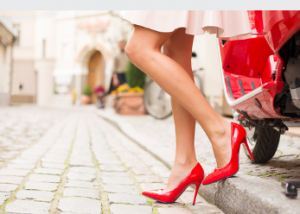In this article, we’ll cover the Femininity of wearing low heels, its health benefits, and Side-effects. We’ll also look at how low heels can improve your walking comfort. And, we’ll examine why wearing low heels can be a good idea for those with bad knees. So, whether you’re a novice or a seasoned heel wearer, we’ll cover some of the benefits of wearing low heels.
 Side-effects of wearing low heels
Side-effects of wearing low heels
Wearing high heels can cause several uncomfortable side effects. The pressure causes the most common, short-term pain in the place of the heel on the front of the foot. In addition, wearing tight shoes can lead to bunions. These painful bumps form when the big toe leans towards the second toe. In severe cases, they can even lead to bunion formation.
Moreover, high heels can lead to swelling in the lower legs during pregnancy. As a result, the pelvic muscles are bent forward, contributing to a rounded back. On the other hand, high heels put pressure on the pelvic and back joints, leading to aches in the lower back area. Therefore, pregnant women are recommended to wear sturdier heels instead of high heels.
High heels may cause lordosis, an abnormal shift in the centre of gravity. Nevertheless, many individuals wear high heels despite the pain and discomfort and even claim that wearing heels helps their posture. However, this is not entirely true, and the altered posture could cause several skeletal conditions, including kyphosis, Dowager’s hump, and lumbar lordosis. These conditions already accompany scoliosis, which could lead to further damage.
High-heeled shoes also cause Achilles tendon shortening. Because of the elevated heel, bringing the heel back to the ground is challenging. People who wear high-heeled shoes all day are most likely to suffer from Achilles tendon shortening. Shortened Achilles tendons also make it challenging to wear flat shoes. These side-effects of high-heeled shoes should only be worn on special occasions.
While high-heeled shoes can give you a stylish look, they can also lead to hammertoe. These painful shoes force your toes into a small toebox, aggravating several foot problems. Wearing high-heeled shoes can also lead to plantar fasciitis, a painful condition that requires surgery. It’s also important to remember that high-heeled shoes can cause injury to your ankle.
High-heeled shoes can increase muscle activity in the lower back, resulting in problems such as osteoporosis and low back pain. Additionally, high-heeled shoes can also lead to a lower pelvic range of motion, which indicates the stiffening of tissue with age. These harmful side-effects of wearing high heels may worsen with age since high-heeled shoes also cause many other physical effects.
The femininity of wearing low heels
In one study, four hundred and forty-eight college students from the Northeast US were asked to rate women who wore high-heeled shoes and women who wore flats. The participants then scored each woman’s physical attractiveness, sexual attraction, and strength. They also rated her femininity, parenting ability, and trustworthiness. The results showed that women wearing high heels were perceived as more feminine than those wearing flats. It may be related to the way women choose to cut their hair.
High heels are a fashion statement, but women who wear them aren’t necessarily trying to be feminine. Instead, they’re attempting to look more masculine than feminine. That is why they wear such high heels. But this has not stopped women from wearing them, despite the gender-neutral stereotypes. Despite the gender stereotype, high heels have long been associated with femininity. Whether or not they’re feminine, they’re certainly an accessory that women aren’t willing to part with.
Health benefits of wearing low heels
Wearing heels for an extended period can result in shortened Achilles tendons, resulting in shorter strides and small calf muscles. Wearing the correct shoes can prevent these problems and help your body recover from wearing bad shoes. Wearing Wildfire AU low heels with good arch support can also help prevent falls, as bare feet are more susceptible to falling. This study was conducted on average women who wore heels for 40 hours a week.